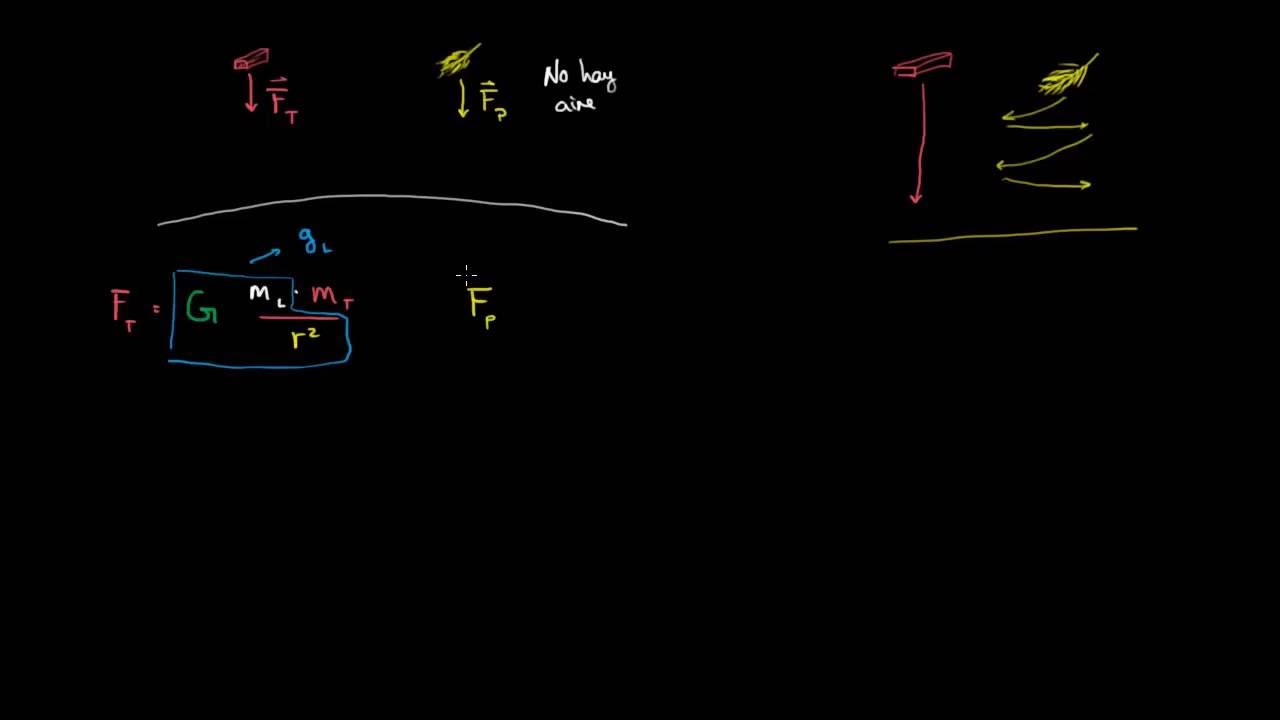Falling objects | Physics | Khan Academy
Summary
TLDRThis engaging video explores the principles of free fall, demonstrating that in a vacuum, all objects, regardless of mass, fall at the same rate due to gravity being the only acting force. It contrasts this with real-world scenarios where air resistance affects falling objects differently, explaining why a bowling ball falls faster than a feather. The video also discusses concepts of weight and weightlessness, emphasizing how normal force changes in accelerating frames, such as elevators. Additionally, it covers projectile motion, illustrating the parabolic trajectories resulting from the combination of horizontal velocity and vertical acceleration.
Takeaways
- 😀 Objects in free fall experience the same acceleration due to gravity, regardless of their mass, when in a vacuum.
- 🎈 In a vacuum, a bowling ball and a feather fall at the same rate and hit the ground simultaneously.
- ⚖️ The gravitational force acting on an object is calculated using the formula F = mg, where g is approximately 9.8 m/s².
- 🐦 Air resistance affects falling objects; the feather falls slower due to quickly balancing its gravitational force with air resistance.
- 🏋️♂️ Heavier objects like bowling balls experience greater gravitational forces but also have more inertia, resulting in the same acceleration as lighter objects.
- 🚫 In the presence of air, objects no longer fall freely due to the opposing force of air resistance.
- ⚖️ Weight is the force exerted on an object due to gravity, but it can vary based on other forces acting on the object, such as in an accelerating elevator.
- 🌌 In free fall (like in a falling elevator), the normal force is zero, resulting in a sensation of weightlessness.
- 🎾 Projectiles, such as a thrown tennis ball, experience free fall when the only force acting on them is gravity, even when moving upwards.
- 📈 The path of projectiles is parabolic due to constant horizontal velocity and vertical acceleration from gravity.
Q & A
What happens when a bowling ball and a feather are dropped in a vacuum?
-In a vacuum, both the bowling ball and the feather fall at the same rate and hit the ground simultaneously because only gravitational force is acting on them.
Why does the bowling ball fall faster than the feather in air?
-In air, the bowling ball experiences greater air resistance due to its larger surface area and higher speed, but it also has a much larger gravitational force acting on it, allowing it to fall faster than the feather.
What is free fall?
-Free fall occurs when the only force acting on an object is gravity, meaning there are no other forces, such as air resistance, affecting its motion.
How does air resistance affect falling objects?
-Air resistance opposes the motion of falling objects. As they fall, air resistance increases until it equals the gravitational force, at which point the object falls at a constant velocity, known as terminal velocity.
What is the relationship between mass and acceleration in free fall?
-In free fall, all objects accelerate at the same rate (9.8 m/s²) regardless of their mass, because the gravitational force acting on each object is proportional to its mass.
What does the term 'weightlessness' refer to?
-Weightlessness occurs when an object is in free fall, meaning there is no normal force acting on it, resulting in the sensation that the object is floating despite the presence of gravity.
How does an elevator's acceleration affect weight perception?
-When an elevator accelerates upwards, the normal force increases, making a person feel heavier. Conversely, if the elevator accelerates downwards, the normal force decreases, making a person feel lighter.
What are projectiles and how do they behave?
-Projectiles are objects thrown into the air that are influenced only by gravity after being released. They exhibit both vertical acceleration downward and horizontal constant velocity, resulting in a parabolic trajectory.
Why can a thrown ball be considered in free fall during its upward motion?
-A thrown ball is in free fall even while moving upward because the only force acting on it is gravity, which causes it to decelerate until it reaches its highest point and starts to fall back down.
What happens to the trajectory of a projectile if it is thrown faster?
-If a projectile is thrown faster, its trajectory becomes a larger parabola, meaning it will go higher and travel farther due to its increased horizontal velocity.
Outlines

هذا القسم متوفر فقط للمشتركين. يرجى الترقية للوصول إلى هذه الميزة.
قم بالترقية الآنMindmap

هذا القسم متوفر فقط للمشتركين. يرجى الترقية للوصول إلى هذه الميزة.
قم بالترقية الآنKeywords

هذا القسم متوفر فقط للمشتركين. يرجى الترقية للوصول إلى هذه الميزة.
قم بالترقية الآنHighlights

هذا القسم متوفر فقط للمشتركين. يرجى الترقية للوصول إلى هذه الميزة.
قم بالترقية الآنTranscripts

هذا القسم متوفر فقط للمشتركين. يرجى الترقية للوصول إلى هذه الميزة.
قم بالترقية الآنتصفح المزيد من مقاطع الفيديو ذات الصلة
5.0 / 5 (0 votes)






